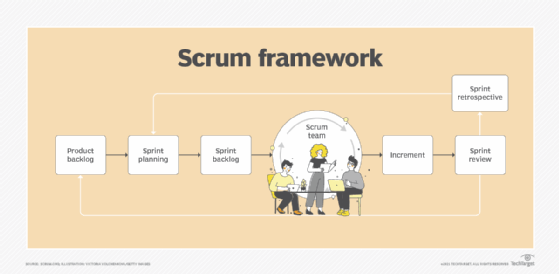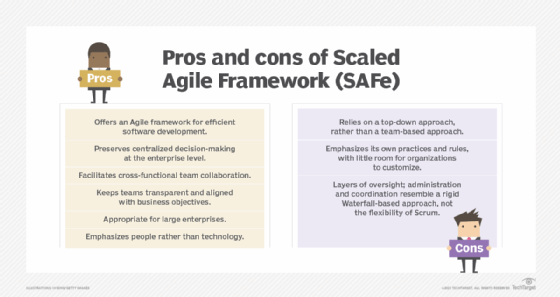
Scrum vs. SAFe: How to choose between top Agile frameworks
Which Agile framework is the best fit for your organization: Scrum vs. SAFe? Follow these guidelines and advice to determine which best fits your needs -- and it might be both.
Scrum and the Scaled Agile Framework (SAFe) are the two most widely used Agile frameworks in the world today. The key difference between Scrum and SAFe is their complexity: Scrum is a lightweight framework that acts as a starting point, while SAFe is a more heavyweight framework with many options to implement as needed.
Both Scrum and SAFe are designed to help teams and organizations deliver incremental value, but they offer different benefits and potential challenges. Here's how to compare their pros and cons and figure out which one is the right Agile framework for you.
What is Scrum?
Scrum is a lightweight framework articulated in the Scrum Guide, which, at only 14 pages long, is easy to understand but difficult to master.
The Scrum Guide provides a minimum set of accountabilities, events and artifacts that must all be present to achieve a successful Scrum implementation. Remove one thing, and you're no longer doing Scrum.
Scrum is primarily concerned with the practice of a single team. A Scrum team is a self-managing and cross-functional group of experts. Together, they have all the skills and experience needed to deliver a valuable increment of their product directly to customers.
The Scrum team works in a sprint, which is a mini project of one month or less. During the sprint, the team members plan, build and deliver an increment of the product to get feedback that informs the plan for the next sprint.

What is SAFe?
SAFe is a more heavyweight Agile framework than Scrum. It provides many tools and approaches from across many different methods and philosophies, including Lean and systems thinking.
The big picture of what's in SAFe illustrates how much more is available to draw upon than in typical Scrum.
Thankfully, SAFe does not expect you to use every available element. Users flex up or down depending on the size of their organization and their project's needs.
Scrum and SAFe similarities
SAFe and Scrum use the same basic approach toward team-level practice. A cross-functional team of experts works in short time horizons: sprints in Scrum and iterations in SAFe.
In both Scrum and SAFe, teams aim to deliver as frequently as possible to maximize the opportunities to seek feedback and adjust their long-term plans.
Scrum and SAFe differences
SAFe mostly builds on top of Scrum practices. Teams are expected to use all the core elements of Scrum. However, SAFe adds a few required elements -- most notably, the release train and the program increment.
Release train
Think of the release train as a team of Agile teams, or a virtual organization. Teams that work on the same product and depend on each other to deliver value maintain a shared mission. The release train uses cadence and synchronization to align team planning and delivery cycles. This maximizes opportunities to deliver value, either to a customer or to another team on the release train.
Program increment
The program increment supports the release train's cadence and synchronization and spans a longer-term planning horizon of eight to 12 weeks. Teams get together and form a rough plan, with goals to make dependencies visible, collaborate on the approach and address any potential risks that might impact their ability to deliver. The plan is not intended to be fixed; once teams begin work, they can and should change the plan based on new knowledge.

How to choose between Scrum and SAFe
Which Agile framework should you choose: Scrum or SAFe? Mostly, this is a question of your organization's size and complexity.
Do you have the ability to start lightweight and empower teams to slowly adjust their approach and introduce additional practices as they learn? Scrum's lightweight framework and implementation through sprints make it the better choice.
Alternatively, maybe you have many teams with deep dependencies that need specific structures in place to enable incremental delivery and support long-term planning. In that case, SAFe is probably the better way to go.
Can I use Scrum and SAFe together?
Scrum and SAFe are two different ways to apply Agile ways of working, but it's possible to use them together.
Individuals can rely on the Scrum Guide to inform their day-to-day Agile practice. At the same time, they can introduce SAFe concepts, such as program increment planning and the release train, to visualize and manage dependencies where it's important.
Scrum requires all its elements to be in place, so it makes the most sense to use the Scrum Guide as your primary rule book and use SAFe as a body of knowledge you can draw from as needed.











